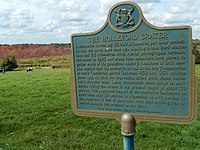| Holleford Crater | |
|---|---|
 Oblique Landsat image of Holleford crater draped over digital elevation model (x10 vertical exaggeration). Although the crater itself is buried, its location (arrows) is marked by a subtle surface depression. Screen capture from NASA World Wind. | |
| Impact crater/structure | |
| Confidence | Confirmed[1] |
| Diameter | 2.35 kilometers (1.46 mi)[1] |
| Depth | 244 meters (801 ft)[2] |
| Impactor diameter | 100 meters (330 ft)[3] |
| Age | 550 ± 100 million years[1] |
| Exposed | No[1] |
| Drilled | Yes[1] |
| Location | |
| Coordinates | 44°27′28″N 76°38′00″W / 44.4578°N 76.6333°W |
| Country | Canada |
| Province | Ontario |
| Topo map | 031C07 SYDENHAM |
The Holleford Crater is a meteorite crater near the community of Holleford, part of South Frontenac, Ontario, Canada. It is 2.35 kilometres (1.5 mi) in diameter and the age is estimated to be 550 ± 100 million years (Ediacaran or Cambrian). Although there is a surface depression over the area, the crater itself is not exposed at the surface.[1]

Holleford Crater was discovered in the 1950s during analysis of aerial photographs under the direction of Carlyle S. Beals of the Dominion Observatory in Ottawa. In the late 1950s, the Geological Survey of Canada conducted a series of four geophysical studies: magnetic observations, seismic studies, gravity studies, and a diamond drilling program. The seismic and gravity studies and the drilling all produced data consistent with the impact theory. The drill core revealed breccia and similar materials at predicted depths. The studies concluded that an ancient meteorite impact crater is present in the Precambrian bedrock below the surface. The meteorite was estimated to be approximately 100 metres (330 ft) in diameter[3] and to have impacted at approximately 55,000 kilometres per hour (34,000 mph).

- ^ a b c d e f "Holleford". Earth Impact Database. Planetary and Space Science Centre University of New Brunswick Fredericton. Retrieved 2009-08-15.
- ^ The Holleford Crater. Holleford, Ontario. 2014-09-09.
- ^ a b Helmstaedt, H.; Godin L. (2008). "Field Trip Guide: Geology of the Kingston Area" (PDF). pp. 15–16. Archived from the original (PDF) on 13 September 2014. Retrieved 29 January 2013.
